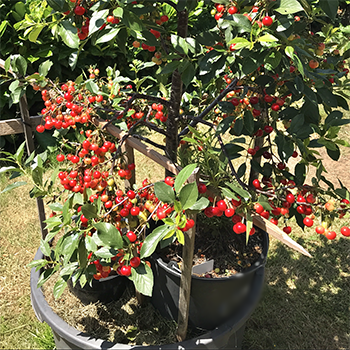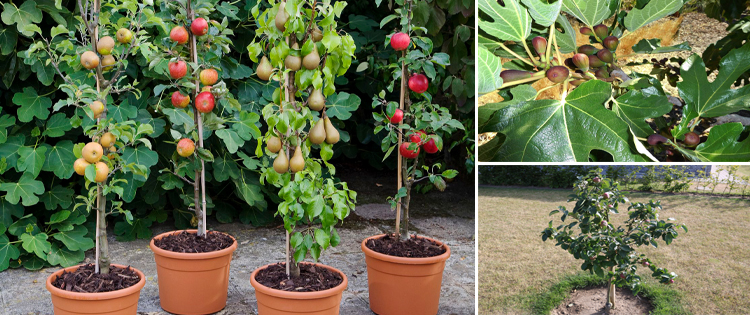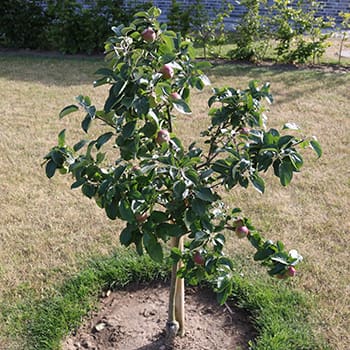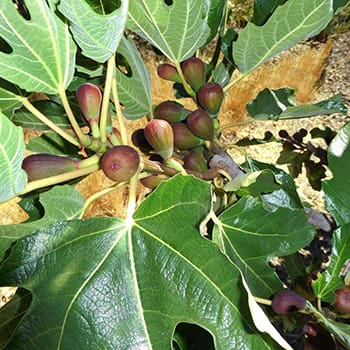The easiest way to grow fruit trees in small gardens is to plant dwarf fruit trees. They reach between 8-10 feet tall and 3 feet in width and need to be planted nine feet apart. You can grow them in the ground, or in pots making them perfect for the vegetable patch, patio, or garden border.
The benefit of dwarf trees is they are easier to look after and manage than their larger counterparts. They also bear fruit faster, but the only downside is they don’t live as long as normal-sized trees. Nevertheless, most of them have a lifespan of 10-15 years.
Keep reading to find out everything you need to know about how many varieties of dwarf trees you can grow in tiny spaces.
Grow Dwarf Cherry Trees
Dwarf cherry trees must be grown in well-drained, water-retentive, fertilized soil. You should definitely avoid drained soil. Grow them in full sun plus good air circulation, so limit the amount of shade. Additionally, you will need to plant two trees to get a good set of fruit. Feed cherries with well-rotted organic mulch, and with a balanced organic fertilizer during the spring.
Birds love cherry trees, so you will need to put a net around them. Also, if you live in a humid climate, look out for fungal diseases such as brown rot. If you catch the disease early, you can contain it.
Cherry trees are also susceptible to insect damage from cherry aphids, or cherry blackfly and will destroy the trunk if left to feed on them. You can protect your cherry trees from pests by using an organic winter wash or glue bands.
Tips for Planting Cherry Trees
- Cherry trees need an inch of water every ten days. If it rains every ten days, this should be enough water. If not, be careful not to overwater your cherry trees or their roots will become soggy.
- Prune your cherry trees at the end of July, or the beginning of August.
- Dry weather is best for picking cherries
Dwarf Fruit Trees: Apple Trees
Apples grow best when exposed to full sunlight for 6 to 8 hours a day. To protect apple trees from strong winds, plant them in a sheltered location. Apple trees need a bucket of water once a week. Maggots love apples, protect your trees by hanging a tangled trap during the summer.
Install a wire-mesh cylinder to deter rabbits and mice, and plant deer-resistant plants such as jasmine, skimmia, rhubarb, or herbaceous peonies next to your apple tree to keep the deer away.
Tips for Planting Apple Trees
- Don‘t fertilize the apple tree when you first plant it, as it might burn the roots.
- If you are planting the tree directly into the soil, make sure all weeds have been removed for at least a diameter of 4-feet.
- Install a strong stake or a trellis to support the plant because dwarf apple trees have a weak root system.
Dwarf Fruit Trees: Cavendish Banana Trees
Dwarf banana trees need 4-6 hours of sunlight per day, since it is a tropical plant, keep the banana tree out of the shade to prevent slow growth. Before planting, mix the soil with some clay, silt, and sand.
Ensure it is well-drained and loamy. Fertilize the soil once every two months, and apply before watering to ensure it gets to the roots. Banana trees need to grow in damp soil, but not muddy or waterlogged. Water the plant every 2 to 3 days.
Banana trees are susceptible to root rot, so look out for this. Common pests include beetles, nematodes, and aphids. Use approved chemical sprays to protect your banana trees from pests.
Tips for Planting Banana Trees
- Once the bananas are ready to eat, remove them from the tree and then use a pruning saw or a machete to cut down the whole stalk.
- Dead leaves protect the roots during the winter months so don’t prune them until the spring.
- Banana trees thrive in temperatures between 80 and 90 degrees F.
- Temperatures below 57 degrees F will affect a banana tree’s growth.
Dwarf Fruit Trees: Orange Trees
Dwarf citrus trees like orange trees need between 6 to 8 hours of full sunlight a day. Water the tree often to keep the soil moist, but not wet. You will also need to fertilize your orange tree twice a month. If you live in an area where frost is likely, either insulate it with a blanket, sheet of plastic, or a large burlap or bring it inside if it’s potted.
Orange trees attract a lot of pests and insects because of their sweet smell. These include scale, spider mites, aphids, and many others. You can get rid of pests and insects with pesticides. Also, look out for abnormal colors or growths on the bark and leaves.
Tips for Planting Orange Trees
- Pruning orange trees so they are kept at about 3 feet in height is essential, or they can grow to ten feet in the garden.
- During the first year, an orange tree needs to use all its energy to grow its branches and trunk. You can restrict it from flowering by pinching the plant’s flowers.
Dwarf Fruit Trees: Fig Trees
Plant a dwarf fig tree in full sunlight. Soil should be moist but well-drained. Fertilize the soil once a year with mulch of well-rotted manure or compost. The fig tree is drought tolerant so it only needs watering every 10 days to 14 days. Make sure the plant is spaced at least four feet, center on center so that the leaves get enough sunlight, and fruit grows on all sides.
Birds and squirrels love fig-trees, cover the tree with a fleece or a net to protect it. Pick the fruit as soon as it’s ripe to prevent them from splitting or the tree will attract wasps.
Tips for Planting Fig Trees
- Fig trees don’t fruit for two years, but after that time if it’s still not producing fruit, it may be because of too much nitrogen or water stress.

- Protect fig trees during the winter months with dry straw or horticultural fleece.
Dwarf Fruit Trees: Apricot Trees
Plant your apricot dwarf tree in well-drained, water-retentive soil. If you live in a cool climate, grow the tree against a sheltered south-facing wall. In warmer climates, it needs full sunlight to grow properly. Keep the base of the tree mulched with straw or wood chips. During the spring months, feed the tree with balanced organic fertilizer.
Protect the apricot tree from insects and animals by placing a protective pipe, or a wire cage around the trunk. Water the tree often until it’s established; after this, you will only need to water it during extremely hot weather.
Tips For Planting Apricot Trees
- If you are in a warm climate, watch out for fungal diseases such as brown rot.
- You can fix oozing resin and dieback by improving the growing conditions.
- Ripe apricots fall off the tree, it’s not a sign of a disease.
- One hour after planting, water the tree thoroughly.
It’s also important to mention that although dwarf fruit trees produce fruit quicker, the supply is far less than a full-size tree. So you’ll have enough fresh fruit for your family to feast on, but canning or freezing won’t be possible unless you grow multiple trees.
You may also like:
The One Tree That Every Homesteader Should Plant
Stop Spending Money At The Pharmacy By Growing These 10 Plants (Video)
Trees In Your Backyard You Should Tap Right Now
Survival DIY Projects You Can Start on Your Property Right Now










